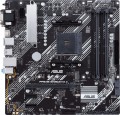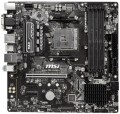Max. clock frequency
The maximum RAM clock speed supported by the motherboard. The actual clock frequency of the installed RAM modules should not exceed this indicator — otherwise, malfunctions are possible, and the capabilities of the “RAM” cannot be used to the fullest.
For modern PCs, a RAM frequency of
1500 – 2000 MHz or
less is considered very low,
2000 – 2500 MHz is modest,
2500 – 3000 MHz is average,
3000 – 3500 MHz is above average, and the most advanced boards can support frequencies of
3500 – 4000 MHz and even
more than 4000 MHz.
Max. memory
The maximum amount of RAM that can be installed on the motherboard.
When choosing according to this parameter, it is important to take into account the planned use of the PC and the real needs of the user. So, volumes
up to 32 GB inclusive are quite enough to solve any basic problems and run games comfortably, but without a significant reserve for an upgrade.
64 GB is the optimal option for many professional use cases, and for the most resource-intensive tasks like 3D rendering,
96 GB or even
128 GB of memory will not be a limit. The most “capacious” motherboards are compatible with volumes of
192 GB or
more - they are mainly top-end solutions for servers and HEDT (see “In the direction”).
You can choose this parameter with a reserve – taking into account a potential RAM upgrade, because installing additional RAM sticks is the simplest way to increase system performance. Taking this factor into account, many relatively simple motherboards support very significant amounts of RAM.
XMP
The ability of the motherboard to work with RAM modules that support
XMP (Extreme Memory Profiles) technology. This technology was developed by Intel; it is used in motherboards and RAM blocks and only works if both of these system components are XMP compliant. A similar technology from AMD is called AMP.
The main function of XMP is to facilitate system overclocking (“overclocking”): special overclocking profiles are “sewn” into the memory with this technology, and if desired, the user can only select one of these profiles without resorting to complex configuration procedures. This is not only easier, but also safer: every profile added to the bar is tested for stability.
SATA 3 (6Gbps)
Number of
SATA 3 ports on the motherboard.
SATA is now the standard interface for connecting internal drives (mainly HDDs) and optical drives. One device is connected to one such connector, so the number of SATA ports corresponds to the number of internal drives / drives that can be connected to the motherboard through such an interface. A large number (
6 SATA ports and more) is necessary in case of active use of several hard drives and other peripherals. For domestic use, 4 is enough. SATA 3, as the name suggests, is the third version of this interface, operating at a total speed of about 6 Gbps; the useful speed, taking into account the redundancy of the transmitted data, is about 4.8 Mbps (600 MB / s) — that is, twice as much as in SATA 2.
Note that different SATA standards are quite compatible with each other in both directions: older drives can be connected to newer ports, and vice versa. The only thing is that the data transfer rate will be limited by the capabilities of the slower version, and in some cases it may be necessary to reconfigure the drives with hardware (switches, jumpers) or software. It is also worth saying that SATA 3 is the newest and most advanced variation of SATA today, but the capabilities of this standard are not enough to unlock the full potential of high-speed SSDs. Therefore, SATA 3 is mainly used for hard drives and low-cost SSDs, faster drives are conn
...ected to specially designed connectors like M.2 or U.2 (see below).M.2 version
The version of the M.2 interface determines both the maximum data transfer rate and the supported devices that can be connected via physical M.2 connectors (see the corresponding paragraph).
The version of the M.2 interface in the specifications of motherboards is usually indicated by the number of connectors themselves and by the PCI-E revision provided for in each of them. For example, the entry “3x4.0” means three connectors capable of supporting PCI-E 4.0; and the designation “2x5.0, 1x4.0” means a trio of connectors, two of which support PCI-E 4.0, and another one supports PCI-E 5.0.
Steel PCI-E connectors
The presence of reinforced
steel PCI-E connectors on the "motherboard".
Such connectors are found mainly in gaming (see "In the direction") and other advanced varieties of motherboards, designed to use powerful graphics adapters. Steel slots are usually made PCI-E 16x, just designed for such video cards; in addition to the slot itself, its attachment to the board also has a reinforced design.
This feature offers two key advantages over traditional plastic connectors. Firstly, it allows you to install even large and heavy video cards as reliably as possible, without the risk of damaging the slot or board. Secondly, the metal connector plays the role of a protective screen and reduces the likelihood of interference; this is especially useful when using multiple video cards installed side by side.
TPM connector
Specialized
TPM connector for connecting the encryption module.
TPM (Trusted Platform Module) allows you to encrypt the data stored on your computer using a unique key that is practically unbreakable (it is extremely difficult to do this). The keys are stored in the module itself and are not accessible from the outside, and data can be protected in such a way that their normal decryption is possible only on the same computer where they were encrypted (and with the same software). Thus, if information is illegally copied, an attacker will not be able to access it, even if the original TPM module with encryption keys is stolen: TPM will recognize the system change and will not allow decryption.
Technically, encryption modules can be built directly into motherboards, but it is still more justified to make them separate devices: it is more convenient for the user to purchase a TPM if necessary, and not overpay for an initially built-in function that may not be needed. Because of this, there are motherboards
without a TPM connector at all.
HDMI version
HDMI connector version (see above) installed in the motherboard.
— v.1.4. The earliest of the standards found nowadays, which appeared back in 2009. Supports resolutions up to 4096x2160 inclusive and allows you to play Full HD video with a frame rate of up to 120 fps — this is enough even for 3D playback.
— v.1.4b. A modified version of v.1.4 described above, which introduced a number of minor updates and improvements — in particular, support for two additional 3D formats.
— v.2.0. Also known as HDMI UHD, this version introduced full 4K support, with frame rates up to 60 fps, as well as the ability to work with 21:9 ultra-widescreen video. In addition, thanks to the increased bandwidth, the number of simultaneously reproduced audio channels has grown to 32, and audio streams to 4. And in the v.2.0a improvement, HDR support has also been added to all this.
— v.2.1. Another name is HDMI Ultra High Speed. Compared to the previous version, the interface bandwidth has really increased significantly — it is enough to transmit video at resolutions up to 10K at 120 frames per second, as well as to work with the extended BT.2020 colour space (the latter may be useful for some professional tasks). HDMI Ultra High Speed cables are required to use the full capabilities of HDMI v2.1, but older standard features are available with regular cables.
Audiochip
The model of the audio chip (a module for processing and outputting sound) installed on the motherboard. Data on the exact name of the sound chip will be useful when looking for detailed information about it.
Modern "motherboards" can be equipped with fairly advanced audio modules, with high sound quality and extensive features, which makes them suitable even for gaming and multimedia PCs (although professional audio work will still most likely require a separate sound card). Here are the most popular modern audio chips:
Realtek ALC887,
Realtek ALC892,
Realtek ALC1150,
Realtek ALC1200,
Realtek ALC1220,
Realtek ALC4050,
Realtek ALC4080,
Supreme FX.

